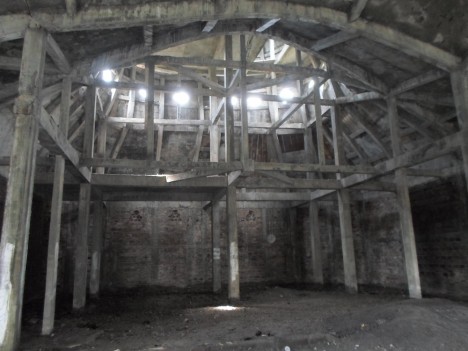CP+ 2016: Things we found that had been cut in half
‘I don’t know, Rishi’, I said in the press room, over warm coffee from a warm can. ‘I don’t know if I should do another ‘things we found that had been cut in half’ slideshow.’ Rishi was silent. I went on: ‘Is it even funny? And there aren’t that many things at the show this year which have been cut in half. Mostly I’ve just seen things which are whole. I don’t know whether I should do it’.
Rishi looked up. There was pain in his eyes. Confusion. The confusion of a child who’s starting to suspect that Santa doesn’t exist but isn’t ready to believe it.
His normally whisper-quiet voice rose slightly. ‘You have to do it’ he said, almost pleading. His voice became louder still – ‘You have to do it. Not because it’s funny – Barney, listen to me. It’s not funny. It has never been funny. But that’s not why you do it. You do it because it’s tradition.’
‘Dammit, Rishi’ I said, straightening in my chair and in the same motion, banging my knees against the oddly low desk, ‘You’re right. And stop yelling, you’re freaking me out’.
CP+ 2016: Things we found that had been cut in half
Could you disappoint this face? I couldn’t.
CP+ 2016: Things we found that had been cut in half
So, without further ado, here’s a selection of things we found at CP+ which had been cut in half. Buckle up, it’s going to be a wild ride*
First up is Nikon’s brand new flagship D5. Capable of taking pictures very quickly of things moving even more quickly, the D5 is as tough as week-old sushi and entirely sealed against dust and moisture incursion. Not this one though – why not? Because this one has been cut in half. Water and dust can get right in, all over the place.
*It won’t be.
CP+ 2016: Things we found that had been cut in half
With pro-level DSLRs being cut in half left right and center in previous years, I think Ricoh has been feeling a bit left out. In fact, I suspect that this is one reason for the much anticipated release of a proper Pentax full-frame camera, the K-1.
The K-1 is a 36MP full-frame camera with a host of solid core photographic features including in-camera stabilization, a revamped AF system, support for legacy Pentax K-mount lenses and little LED lights hidden in clever places all over the camera body. The rear LCD is articulated, using an innovative and unusual strut and hinge design, and the shifting sensor can be used to create full-color resolution exposures, correct wonky horizons and even track stars for night shots.
This K-1 can’t do any of that though, because it’s been cut in half. This one is literally useless.
CP+ 2016: Things we found that had been cut in half
An early prototype of the K-1, before Ricoh’s engineers realised that using clear plastic would cause serious light-leak issues.
CP+ 2016: Things we found that had been cut in half
Here’s a blast from the past – a Nikon F from the early 1960s, cut in half good and proper. A period of huge social change, the 1960s saw revolutions on several fronts – sexual, social, political and photographic. This was the decade of TTL metering, removable prisms, wideangle lenses and motor-drives. Before the 1960s, the idea that a professional camera could be displayed like this – bisected, with its delicate parts exposed to public view – would have been unthinkable.
How much has changed. Yet how much remains the same.
This Nikon F could be yours for only ¥248,000 (~$ 2200). Superglue not included.
CP+ 2016: Things we found that had been cut in half
In many ways a more innovative camera than the Nikon F, Canon’s F1 (which came along a little later) proved itself a solid, reliable workhorse for Canon FD photographers in the 1970s. With TTL metering built in (not via an optional metering head, as with the Nikon F) an optional (and insanely noisy) 3.5fps motordrive and a faster maximum shutter speed, the F1 was popular among sports and action photographers.
There’s no way this one is being used to photography any sports or action though. Not only are the mercury cells that powered the F1 unavailable these days, this camera has been cut in half. It’d just fall sideways off the tripod.
CP+ 2016: Things we found that had been cut in half
Sony had a big booth at this year’s CP+ show, and as well as a new camera, the 24MP a6300, the company was also showing off three new ‘G Master’ lenses. Designed to cover the full-frame imaging area of the company’s a7-series mirrorless interchangeable lens cameras, the new 24-70mm F2.8, 70-200mm F2.8 and 85mm F1.4 are the most convincing pro-level optics yet released for Sony’s FE mount.
Here’s the new FE 70-200mm F2.8 GM OSS. Comprised of a remarkable 32 elements in 18 groups, elements include one double-side aspherical and one extreme aspherical element, plus ‘Nano AR’ coating. This particular lens is even more complex, being made up of 46 elements in 36 groups. Because it’s been cut in half. Bonkers!
Read more about Sony’s new G Master lenses
CP+ 2016: Things we found that had been cut in half
Oooh, look at all that lovely glass. This is the Sony FE 85mm F1.4 GM portrait prime, sliced wide open for all to see. This lens comprises 11 elements in 8 groups, and features a new XA (extreme aspherical) element which has been rendered even more aspherical in this lens by being cut in half.
Read more about Sony’s new G Master lenses
CP+ 2016: Things we found that had been cut in half
The third lens in Sony’s new G Master trio is the FE 24-70mm F2.8 GM, which is intended as a standard zoom for Sony’s flagship a7R II. Our intial impressions of image quality from this lens are very encouraging, but it’s the Direct Drive SSM autofocus motor which has us most impressed.
When paired with an a7R II this lens acquires focus – and can continue to focus on moving subjects – extremely quickly. We didn’t get the chance to try out the performance of this particular sample, but we’re pretty confident that it won’t be great. After all, it’s been cut in half.
Read more about Sony’s new G Master lenses
CP+ 2016: Things we found that had been cut in half
Sensors come in all manner of shapes and sizes – actually no, that’s not really true, but they come in all manner of sizes at least. From full-frame on the Sony booth to Micro Four Thirds at Panasonic, here’s the company’s new Leica DG Vario-Elmar 100-400mm F4.0-6.3 ASPH Power OIS. Optically much simpler than Sony’s 70-200mm, the Leica 100-400mm is equivalent to a 200-800mm lens when attached to a Micro Four Thirds body.
It has has one aspherical, one UED, and two ‘regular’ ED elements, as well as a nine-bladed circular aperture. Or it would, if it hadn’t been cut in half. We didn’t get the chance to shoot with this sample yet but we’re pretty sure it’s going to give some very ugly bokeh.
CP+ 2016: Things we found that had been cut in half
Here’s the Olympus M.Zuiko Digital 300mm F4 IS Pro, which offers an equivalent focal length of 600mm in full-frame terms. This lens has impressed us with its sharpness, durability and relatively light weight. This one is even lighter than normal, but much less resistant to the elements. It’s been cut in half, you see. Very silly.
CP+ 2016: Things we found that had been cut in half
When it comes to cutting things in half, Zeiss is one of the best companies out there. And as usual, the Zeiss stand was a positive orgy of bisected primes, split zooms and half-naked wide-angles. Here’s the company’s Zeiss Milvus 21mm F2.8, which retails for almost $ 2000 normally. This one isn’t worth even half of that amount though. Off-center performance (on one side only) is terrible, because it’s been cut in half.
CP+ 2016: Things we found that had been cut in half
Hey, remember the tiny, cute little Voigtländer VM 40mm F2.8 Heliar we wrote about last year?
CP+ 2016: Things we found that had been cut in half
It looks even tinier and cuter when it’s been cut in half.
CP+ 2016: Things we found that had been cut in half
Less small but still pretty cute is Tamron’s new SP 90mm F2.8 Di VC USD 1:1 Macro, the latest version in a line of very well-regarded 90mm macro lenses from Tamron stretching back decades. Weather-sealed with a built-in vibration correction stabilization system we’re really looking forward to seeing how this new macro prime performs. Not even Vibration Correction will get sharp results out of this one though though – this one has been cut in half.
CP+ 2016: Things we found that had been cut in half
An etymological diagram of the human brain, cut in half. These are the literal translations of latin terms for the various brain regions. After 4 days at CP+, Rishi and I are mostly creating content from our ‘Little Brain’ area, although my Slime Gland has been giving me trouble. It’s probably just the jet-lag.
We’ve got more content lined up for you over the next few days, including some more technical analysis of Nikon’s D5 and D500, and interviews with senior executives from Canon, Nikon, Ricoh and more. Thanks for reading and goodbye (for now) from Yokohama.
Articles: Digital Photography Review (dpreview.com)



























































































You must be logged in to post a comment.